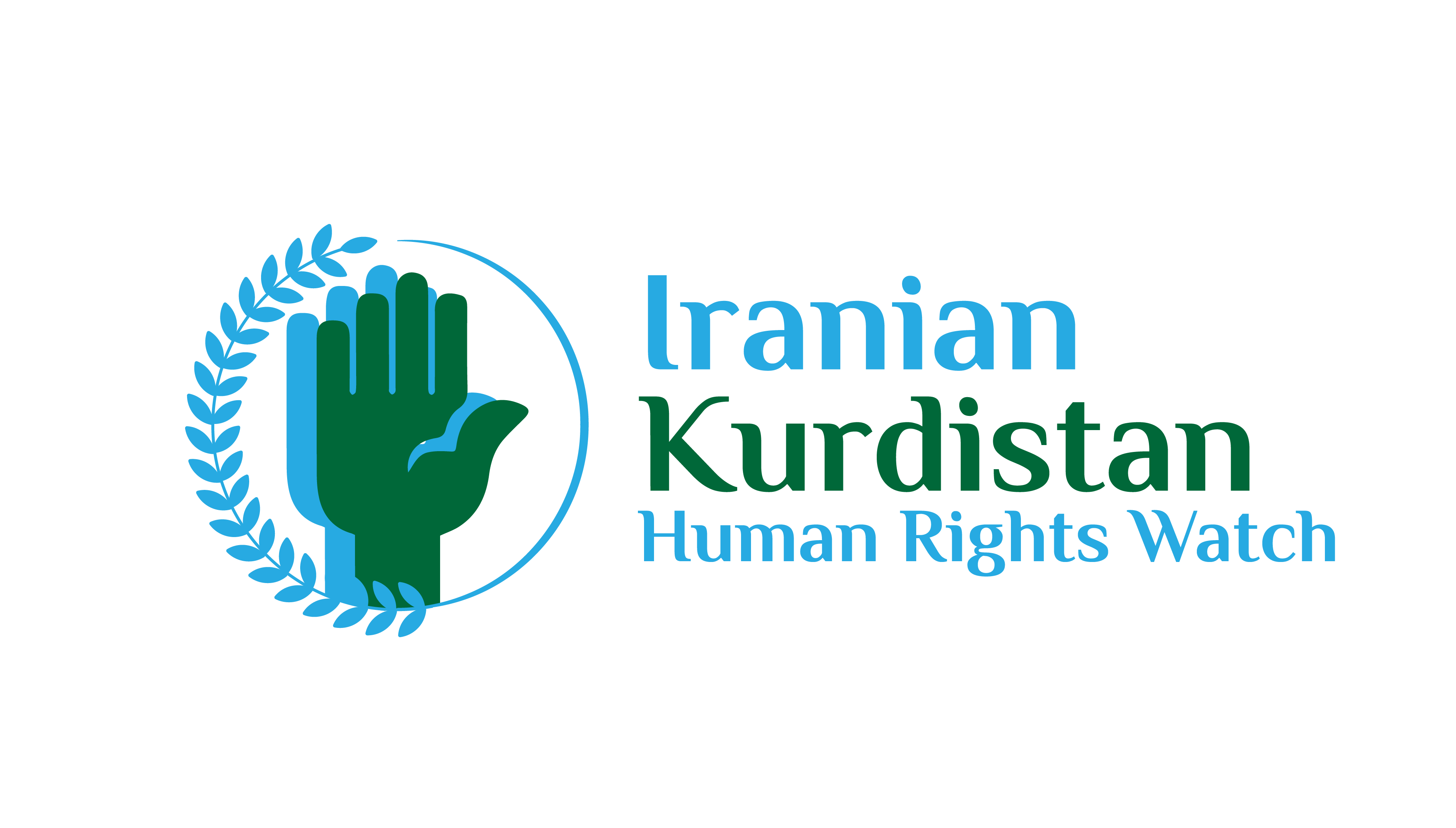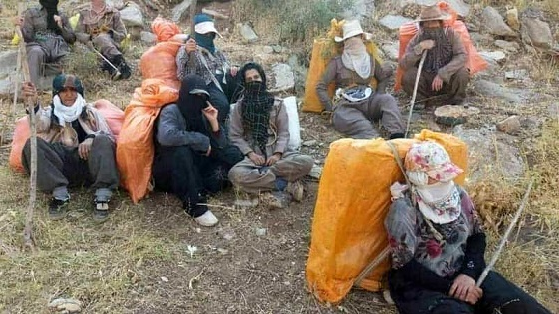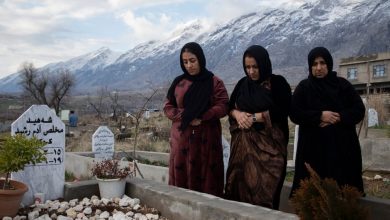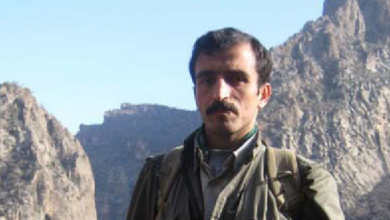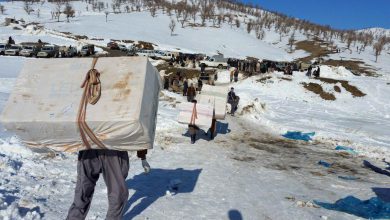Arasteh, a woman, has been kolbarring (illegally carrying goods from the border) with her husband for the last four years. She looks like a 50-year-old woman, but as she herself says that she is under 40. Arasteh only goes kolbarring twice a week. She is not able to continue any more. Mrs. Arasteh suffers from lumbar disc and grave leg pain. She earns 200,000 tomans ($8) a night for kolbarring, of which she has to pay 60,000 tomans ($2.5) for road fare.
“By the time we get home, the money from kolbarring overnight is paid to buy packages of bread and eggs and two or three kilos of fruit and that’s over,” she says. “Nothing is left.” They walk for 10 hours a night in the snow and storm, near the border of Tete Mariwan, while fearing and trembling with lots of worries. No one but her husband knows that she is kolbarring. She wears men’s clothes and covers her face, like other women.
Mrs. Arasteh says she knows at least 40 women who kolbar like her, sometimes more. Men can lift up to 40 kg, but women can lift up to 30 kg. They do not have the needed strenght and the power. It is difficult to get out and kneel in the snow with this amount of load on your back. Arasteh says she and her husband kolbar so that they can earn money, while breathing. She talks painfully and at the end of the day, with a broken face and sad eyes, she asks: Do you think death is not better than this life?
Getting money at the cost of life
We get money at the cost of life here. You have to carry a heavy load to be able to feed your families, just feeding. You have to pull heavy packages in the snow-covered alleys of the Mariwan and the mountains on the western borders of Iran and Iraq. Then, at the end of the day, one has to eat a little bread so as not to die, and stay at home for two whole days, to refresh and stand up again, day after day, this is repeated. Kolbarring at the cost of life, at the cost of health.
An undeniable truth
Kolbarring remains confused. It is not clear when this problem will be solved. While there is no exact and documented figure on the number of Kolbars who move the western highlands in search of money, unofficial estimates say the number is 80,000 to 170,000.
There is no report on the number of the women kolbarring. Although the evidence says their number is high, but they are also increasing day by day; from teenage girls to older women, edcucated or uneducated.
Perhaps until a few years ago, it was possible and and turned a blind eye to the facts, but for example Mohsen Bigleri, a former representative of the people of Saqqez and Baneh in the Islamic Consultative Assembly, said: “It is a hard work and life-threatening. The idea of such a phenomenon seems difficult and unbelievable.”
These days, however, the story of women’s kolbarring in the three border provinces of Kurdistan, Kermanshah and West Azerbaijan is undeniable.
One is a housewife, the other is a kolbar
The night that Bojaneh’s husband was brought and left behind in the house and left, the young woman struggled and took the burden of life on her weak and helpless shoulder. Her husband had been thrown from the top of the mountain during kolbarring, in the middle of the night in the cold winter. Some people got him in a car and brought back to the house.
Her husband was broken the vertebrae and his shoulders were dislocated. He was lucky that his head did not hit the rocks and rocks and came down on his back. No insurance, no disability, no savings and no support. Bojaneh was not even 30 years old when her husband had to stay at home and she became a kolbar herself. She ran to the heart of the mountain to feed her family. Less than five years ago, she left kolbarring and is a 35-year-old woman who no longer can continue. Her knee joints have become severely worn and are no longer capable, especially on nights when the cold weather pushes the cold to the depths of bones.
Bojaneh says she had no choice but to live with kolbars. Her husband is now lying in the corner of the house, and after all needed medical treatments, he can just sit up, with help. Bojaneh goes kolbarring three days a week to feed her family with two small children. When she gets home, she rests for one or two full days to recover and get back on her feet. The total income of a young woman with three days a week is less than 2 million tomans ($80) a month.
The young woman is weeping: Kolbarring is darkness. It is unfortunate. You either get shot, or you fall down a mountain, then stay alive but disabled.
Do not take it serious
Unemployment rate is high in Iran and higher in western provinces; specifically in Kurdistan province, twice the national average. Unemployment raises and is the root of problems such as kolbarring. Kolbarring is a bitter reality of society. It has been two or three years since the State said of organizing kolbars, and even a plan has been formulated by the Ministry of Interior to organize their activity, and has been announced more or less with a gap of three years. A plan that emphasizes the creation of cross-border markets; markets, of course, have been shut down by sanctions and currency fluctuations. After all, to date, no effective and significant action has been taken to eliminate kolbarring and the resulting social, cultural, political and economic inadequacies that can be reflected. At the moment, everything nothing has been done but slogans.
A hand that fixed crookedly
Delshad does not have a husband but has 7 small children. Her husband had a car accedent two years ago and the driver escaped. She is caregiving her children. She did not know anything, and had no specialty. The only option for her was kolbarring. She knew several women in the village who were kolbarring. She ordered to be taken with them.
Delshad was small. They were afraid she would not be able to cope. In the first session, he carried 40 kilos on her shoulder and all, she relieved everyone. The load was almost equal to her weight. The first nights were very hard. Cold and hard on one side, fearingthe police on the other side. What would her children do if she was arrested or harmed? Who was going to feed them? One night she was thinking and her feet went down. He leaned on a rock so that the rain would not hit the rock and cause damage. He heard the sound of a broken elbow in her hand, and a terrible pain filled her whole body. She was silent and said nothing. Other kolbars picked her up and she started walking again. When she got home in the morning, she saw that her left elbow got black. She wanted to go to the clinic but could not. She gave breakfast to her children and fell down.
Delshad added she slept soundly until evening to go kolbaring again. Kolbarring twice a week can not feed the children. It is repeated. She forgot her elbow but it remained crooked. Now Delshad’s left hand is crooked and both of her legs suffer from rheumatism.
To be or not to be; this is the problem
The question that can be asked is: Why, to date, no basic and principled measures have been designed and implemented to eliminate kolbarring and to empower people, especially women, to get rid of this problem? Although more or less all kolbarring-related officials and stakeholders agree that people are forced to do so and the necessities of life force them to accept the danger and hardship for a piece of bread, there are different views on kolbarring. A group of officials emphasize on organizing and directing the process of transportation of goods by kolbars. For example, Mehdi Isazadeh, a representative of the people of Miandoab and the head of the social commission of the 11th parliament, believes that a comprehensive look should be given to kolbarring.
Emphasizing that kolbarring has could have many meanings, Isazadeh says: “Maybe it would be better to define a path for kolbarring and organize and guide the kolbars to move certain goods.”
On the other hand, there are officials who consider kolbarring to be against their dignity and human dignity, and emphasize that kolbarring’s livelihood problems must be solved scientifically and sustainably. These officials emphasize that if it is a job or a business, most of the kolbars will give up this job for their rivals.
NGOs have come to field
Recently, a number of social service institutions and non-governmental organizations have taken steps to solve the problem of kolbarring and create sustainable employment for kolbars and empower them, and have even presented and implemented projects. Among them, the Barakat Foundation, as one of the subdivisions of the Executive Headquarters of Imam Khomeini, has announced the identification of women in three provinces of Kurdistan, Kermanshah and West Azerbaijan and the creation of employment for 330 of them. The foundation also announced the creation of 11,000 jobs for kolbars by the end of this year, emphasizing that kolbar women will be a priority for the 15,000 new jobs created in 2021.
